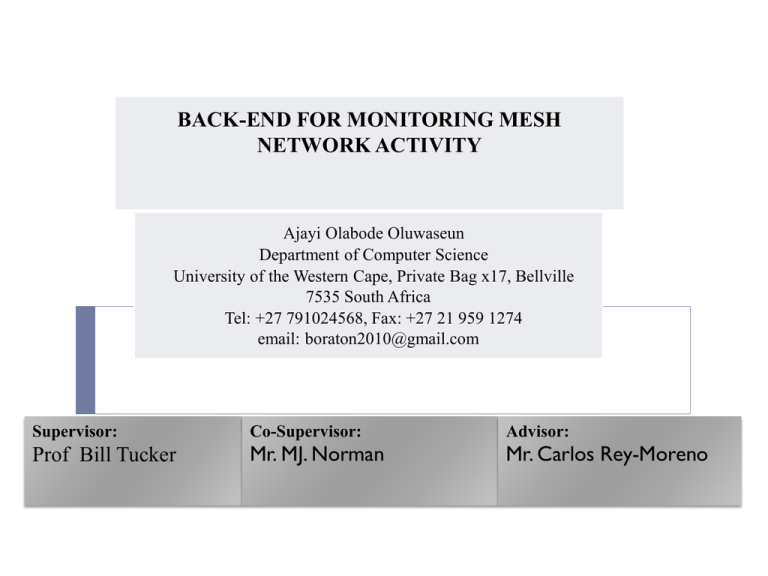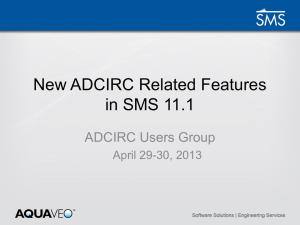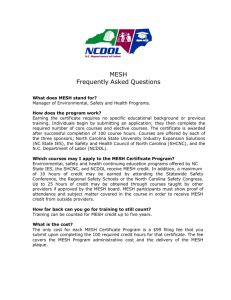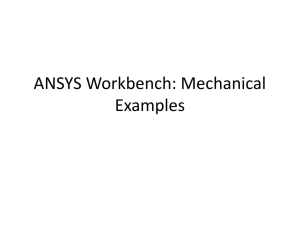Presentation - UWC Computer Science
advertisement

BACK-END FOR MONITORING MESH NETWORK ACTIVITY Ajayi Olabode Oluwaseun Department of Computer Science University of the Western Cape, Private Bag x17, Bellville 7535 South Africa Tel: +27 791024568, Fax: +27 21 959 1274 email: boraton2010@gmail.com Supervisor: Co-Supervisor: Advisor: Prof Bill Tucker Mr. MJ. Norman Mr. Carlos Rey-Moreno INTRODUCTION This project will demonstrate; A backend application for monitoring a mesh network activity for organization (e.g. UWC) The configuration of a remote gateway on mesh potatoes A wireless network integrated with wireless fidelity (Wi-Fi) An agile methodology due to constant changes in mesh network activity The rate used with each neighbor and on active links (Quality of link) BACKGROUND This project proposed to; Minimize the storage capacity of the mesh potatoes when outputting data information for decision making process Frequently checking the values and/or mechanisms to compress the data explored before sending it to the database server REQUIREMENTS DOCUMENT The requirements for this project include; User’s (network manager) view of the problem: Complexity on mesh network activities, and huge amount of data on a mesh device. Brief description of the problem domain: A network manage is finding a way to minimize the time expending on collecting data. What is expected from the software solution? Increase the effectiveness of the data transfer between a node and the centralized database servers. REQUIREMENTS ANALYSIS Designer’s interpretation of the requirements Scenario: User (Network manager) wants a system that will help him carry out daily network monitoring as shown in the following diagram. FRONTEND APPLICATION CENTRALIZED DATABASE SERVER MP_B IP_Add: 172.16.39.22 MP_D IP_Add: 172.16.39.22 MP_B IP_Add: 172.16.39.21 MP_C IP_Add: 172.16.39.23 Network MANAGER REQUIREMENTS ANALYSIS The system architecture for this project will include two components: Hardware Component e.g. Mesh Potatoes hardware overview; One 10/100Mbit LAN port,8 MByte Serial Flash EEPROM,16 MByte RAM (device storage space) etc. Software Package Component e.g. The application File Extractor module as shown in the following diagram will use Extract, Transform, and Load (ETL process); MP_B IP_Add: 172.16.39.22 MP_D IP_Add: 172.16.39.22 MP_B IP_Add: 172.16.39.21 Wireless Mesh Network Set-up MP_C IP_Add: 172.16.39.23 Data values extracted Software Configuration file reader Load Database Configuration Transform Backend Application Collected values Scenario Data Able to integrate seamlessly with the frontend Application PROJECT PLAN Term1 Understanding the problem facing Organization e.g. UWC Interview with Mr. Carlos Rey-Moreno Gather the user requirements Meeting with the supervisor Reading the specifications of the Mesh Potato and SECN firmware Installation of MySQL database, and Java database driver Still leaning towards MadWifi and Batman-adv routing protocol. Term 2 Term 3 Term 4 Designing and preparing the prototype Implementation and coding Testing and Evaluation REFERENCES [1] Aichele, C., Wunderlich, S., Lindner, M., and Neumann, A. Better Approach To Mobile Ad-hoc Networking (B.A.T.M.A.N.) draft-wunderlich-openmesh-manet-routing00. 2008. [2] Learning b.a.t.m.a.n-adv, http://www.open-mesh.org/projects/batman-adv/wiki Accessed 01 March 2013 [3] Mesh Potato, http://villagetelco.org/mesh-potato/ Accessed 01 March 2013 [4] Rendered Concept Of A Backend And Frontend Of A System www.shutterstock.com Accessed 25 March 2013 CONCLUSION Thank you











